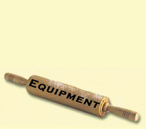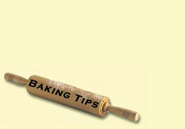| |

Bread
Making Methods
There
are four main operations, or methods, of preparing bread dough for
baking:
- The Sponge,
or Long Method ~ The yeast "works' with moisture, flour
and a few other ingredients, usually overnight, before being mixed
with the rest of the dough. Kneading and rising follow.
- The Straight
Dough Method ~ All the ingredients are mixed, step-by-step,
before kneading and rising periods.
- The Batter
Dough Method ~ One mixing operation, with all ingredients,
with no need for kneading and shaping (as liquids usually "out
proportion" flour), and often only one rising period, after
which dough is spread in pans or is spooned into tins.
- The No-Knead
Method ~ A thorough mixing operation, with no kneading, one
rising period, and the dough is usually dropped or spooned into
baking containers.
The basic ingredients
for yeast breads are wheat flour, yeast, liquid-usually water or
milk- salt, sugar and fat-lard, butter margarine, salad oil or shortening.
More flour is used than any other ingredient. The magic in flour
is gluten, a protein. When you mix flour with liquid and manipulate
the mixture by beating, stirring and kneading, the gluten develops
in long elastic strands that stretch and trap the bubbles of carbon
dioxide gas which yeast gives off as it grows. It's these bubbles
that cause dough to rise and bread to become light. Gluten forms
the framework of bread, enabling the loaf to hold its shape when
baked.
Hard Wheat contains more gluten than soft wheats. Some supermarkets
carry bags of flour labeled "high protein" and "for
bread making," but most flour marketed today is all-purpose,
a blend of hard and soft wheats. It contains enough gluten for bread
making and not too much for cake making.
Yeast consists of living plants, which feed upon sugar and flour
as they multiply. They give off carbon dioxide gas, which makes
dough rise.
*Basic
Bread Making Method
- In mixer
bowl combine flour and yeast according to recipe directions. In
saucepan heat together liquid butter, margarine or shortening
with sugar and salt just till warm (115 to120 0). Pour over flour
and yeast mixture. Add egg. Beat thoroughly (beat at low speed
of an electric mixer for 1/2 minute, scraping the sides of the
bowl constantly. Then beat at high speed 3 minutes.)
- Stir in as
much of the remaining flour as you can mix in with a spoon. Measure
the remaining amount of flour before starting to add it to the
dough. This way you won't lose count. (Do not try to use your
electric mixer for this step unless it is specially equipped to
handle heavy doughs).
- Turn the
dough out onto a lightly flour surface-a pastry cloth is ideal.
Knead in enough of the remaining flour to make the dough the stiffness
described in the recipe. You may not need all the flour you've
measured. To knead, fold the dough over and push down with the
heels of your hands. Give the dough a quarter turn, then fold
over and push down again.
- Place the
ball of dough in a greased bowl, turning once to grease surface
to prevent drying. Let the dough rise in a warm place till it
doubles in size. Times suggested in the recipe are guidelines;
the actual time needed may be a bit more or less. Dough is ready
to shape when you can lightly press two fingers 1/2 inch into
the dough and the indentation remains.
Source: 'Baking
Ideas' 1980/81 from Better Homes and Gardens.
"There are many cooking books on the market but I have found
that the 'absolute best' all around cookbook is the Better Homes
and Gardens cookbook with the red and white checkers on it. I am
always on the lookout for them at garage sales, book stores, supermarket
bookshelves etc. It is the one gift that 'saved' my marriage in
early years and I have never forgotten it. I give them as birthday
and Christmas gifts to teens who are almost ready to step out on
their own, to married couples as a wedding gift etc. Why? They are
easily understood and the recipes are practical and taste great!
"
Sally v Smith, mother of 5 grandmother of 14, homemaker, working
wife.
Methods/Tips
Mixing:
A thorough mixing is a must for the even distribution of the yeast
and other ingredients. Sifting of the flour and scalding of the
milk is done before mixing the ingredients. For many parts of the
world, proofing the yeast in water (to make sure it is still alive)
is also necessary. In the USA the active yeast in the supermarkets
is often ready to go right in the flour. However, if it has been
too long in the refrigerator, it is wise to proof it by letting
it sit in water with a little sugar added. If it is not bubbly after
10 to 15 minutes, it is not working and you need some fresh.
How much
Flour to add: Add enough flour at mixing or kneading time to
prevent the dough from sticking to your hands-keep it as soft as
you can handle it. If you add flour after the dough has risen, it
may make dark streaks and coarsen texture.
Kneading:
Turn dough out on lightly floured surface. Flatten it with the palms
of your hands. Then pick up the farthest edge and fold it over to
the edge nearest you. Curve our hands over the dough and push gently,
but firmly three or four times. Turn the dough a quarter of the
way around, fold it over on itself again and push. Repeat this folding,
turning and pushing until the dough is smooth and elastic. You will
see small bubbles under the dough's skin. Let it rest for a few
seconds. Roll the dough into a ball, place it in a greased bowl,
turn over once (or oil top of dough) and cover with clean cloth.
Rising:
Allow the yeast to act, for good texture and flavor, in a draftless
spot at 83 to 99 degrees F - never too cool or too warm. Cover with
a clean cloth, damp or dry, waxed paper or a glass bowl; place the
bowl of dough in the oven over a pan of hot water. Sometimes, it
is enough just to place it inside the oven door, especially in the
summer. You want it warm not hot, so don't put it in a heated oven.
Shaping or
Molding: After the dough has risen for the last time, cut it
into equal portions and roll them into balls. Well-worked dough
may be molded into whatever shape you desire. If flattening the
dough into a rectangle (by hand or rolling pin), pressing out the
bubbles. Fold first one long side over to the center, then the other
so that they overlap. Roll the dough into a loaf, sealing and tucking
under the inner edge. Place in a greased pan with the seam side
at the bottom. For a softer crust, brush the tops of the loaves
with shortening (oil or butter) after baking. For a glazy-crispy
crust, brush the tops of the loaves with a mix of egg white and
water before baking. Some people add cheese or onion slivers to
the top either before baking or the last 5 minutes.
Baking:
Baking stops the rising process, induces a wonder fragrance, sets
the conditioned gluten and makes bread. Thoroughly baked breads
are golden brown, pull away slightly from the pan sides, and sounds
hollow when you thump it (knowing what hollow sounds like in bread
takes practice).
Cool loaves completely before putting them in a breadbox, plastic
bags, or foil.
Tips:
What
went wrong?
The dough
will not rise.................
This is probably the worst thing that will happen, and your best
bet is to start all over again. Some of the reasons for dough not
rising are:
- The yeast
was too old. (Always check the expiration date on the dry yeast
packages. With fresh yeast, make sure that it is not dried and
brown.) Yeast can be 'proofed" - checked for viability by
putting it in 1/4 cup warm water with 1 teaspoon sugar-if it bubbles
on top in 15 minutes it is probably fine.
- Your liquid
was too warm. The ideal temperature for the liquid in which you
dissolve or proof the package, granulated yeast is from 105 to
115 degrees, and for the fresh (compressed) yeast, 95 degrees.
- The flour
was too cold. If you keep your flour in a cold place, make sure
to take it out in time to reach room temperature before you start
to bake.
- You put the
dough in a place that was too cold or too drafty for it to rise.
- Maybe you
worked it too long.
The finished
bread is too hard..............
This is a common occurrence among new bakers, but is nothing to
worry about. With more practice your bread will improve. You can
still enjoy the hard bread. Just slice it very thinly and spread
with lots of butter. Or, use the thin bread slices as base for stuffing
and dressing, or even better, spread with herb butter, dry it in
a low heat oven and make croutons.
- Too much
flour in the dough is the usual reason for hard bread.
- Too much
sugar could also be the cause, or perhaps you did not let the
bread rise long enough after it was shaped.
The bread
seems too heavy.........
The reasons might be:
- Your oven
was not hot enough
- You may have
put too much sugar into the dough.
- It didn't
rise long enough after you shaped it.
The bread
has cracks on top of the crust......
Not a very serious problem.
- You did not
mix the dough enough.
- The bread
contains too much flour.
- You didn't
let the bread rise long enough after it was shaped.
The bread
rises over the brim of the baking pan......
- Your baking
pan is too small.
- You used
too much leavening.
- The over
was not hot enough.
|







